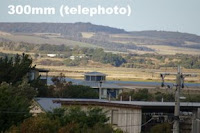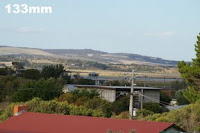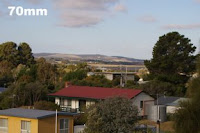Increasing the focal length of the lens you use (either by changing the lens on a DSLR, or zooming in) narrows the field of view and magnifies the subject (making it look closer). Higher focal length lenses are called telephotos. Decreasing the focal length expands the field of view and the image looks further away. Lower focal length lenses are called wide angle, because of their wider angle of view.
So here is a demonstration of the magnification and field of view obtained with different focal length. To fully appreciate the difference in magnification involve try if you can see the small "turret" on the house in the middle on the first image at the top, in the final image at the bottom. You will need to click on the images to see the larger versions.









Whilst a 50mm lens best matches the perspective and magnification of the human eye on older 35mm film cameras, a focal length of 33mm approximates the normal human vision on a digital camera, which has a smaller CCD sensor area.
If you are interested you can find the focal length used for images in the EXIF data embedded in most Jpeg or RAW file formats these days
Changing the focal length also changes the perspective but that can be the topic of another post.
No comments:
Post a Comment